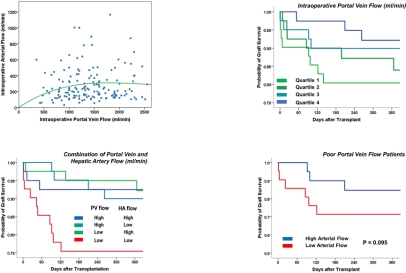Sufficient Hepatic Artery Flow Redeems Poor Portal Vein Flow after Liver Transplantation in Patients with Porta Vein Thrombosis
General Surgery, Cleveland Clinic, Cleveland, OH.
Meeting: 2018 American Transplant Congress
Abstract number: A235
Keywords: Graft survival, Hepatic artery, Liver transplantation, Portal veins
Session Information
Session Name: Poster Session A: Liver Retransplantation and Other Complications
Session Type: Poster Session
Date: Saturday, June 2, 2018
Session Time: 5:30pm-7:30pm
 Presentation Time: 5:30pm-7:30pm
Presentation Time: 5:30pm-7:30pm
Location: Hall 4EF
Objective:Although portal vein thrombosis(PVT) in liver transplantation is no longer a contraindication, it remains technically challenging. Insufficient intraoperative PV flow after PV thrombectomy/reconstruction was reported as correlated with poor outcomes. Hepatic arterial(HA) buffer response is a well-known phenomenon representing the ability of the HA to produce compensatory flow according to PV flow. This study investigated the role of HA flow in patients with PVT, especially those with low intraoperative PV flow
Methods:This study included PVT patients with complete intraoperative flow data transplanted from 2004-2015. Clinical characteristics and 1-year graft survival were investigated. The degree of association between non-parametric variables was determined using Pearson's correlation coefficient. The Kaplan-Meier method was used to assess prognostic outcomes. P<0.05 was defined as significant.
Results:Of 163 PVT patients, 138 patients had partial and 25 had complete PVT. The median MELD score was 2(IQR20-27) and 1-year graft and patient survival were 87.3% and 88.2%, respectively. Intraoperative PV flow was 1396ml/min(IQR;1006-1900) and the median HA flow was 208ml/min(IQR;138-359). PV and HA flow had no statistical correlation(R=0.091, P=0.250). The estimates of graft survival for each PV flow quartile showed risk of 1-year graft loss increased with decreased PV flow. When the whole cohort was stratified by 4 groups according to high/low PV and HA flow, high HA flow significantly improved 1-year graft survival in low PV flow patients(P=0.031). Moreover, high HA flow improved outcome in worst quartile PV flow patients, although this did not reach statistical significance(P=0.095)
Conclusions:Sufficient HA flow would compensate liver blood supply instead of poor PV flow. High certainty HA reconstruction might be a key to achieve good outcomes in PVT cases.
CITATION INFORMATION: Coromina Hernandez L., Sasaki K., Firl D., McVey J., Fujiki M., Aucejo F., Eghtesad B., Quintini C., Miller C., Hashimoto K. Sufficient Hepatic Artery Flow Redeems Poor Portal Vein Flow after Liver Transplantation in Patients with Porta Vein Thrombosis Am J Transplant. 2017;17 (suppl 3).
To cite this abstract in AMA style:
Hernandez LCoromina, Sasaki K, Firl D, McVey J, Fujiki M, Aucejo F, Eghtesad B, Quintini C, Miller C, Hashimoto K. Sufficient Hepatic Artery Flow Redeems Poor Portal Vein Flow after Liver Transplantation in Patients with Porta Vein Thrombosis [abstract]. https://atcmeetingabstracts.com/abstract/sufficient-hepatic-artery-flow-redeems-poor-portal-vein-flow-after-liver-transplantation-in-patients-with-porta-vein-thrombosis/. Accessed December 29, 2025.« Back to 2018 American Transplant Congress
